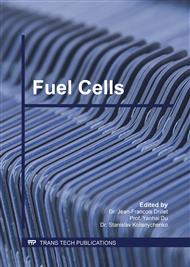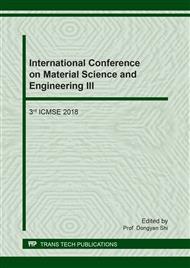[1]
S. P. S. Shaikh, A. Muchtar, M. R. Somalu, A review on the selection of anode materials for solid-oxide fuel cells, Re Renew. Sustain. Energ. Rev. 51 (2015) 1-8.
Google Scholar
[2]
P. Kim-Lohsoontorn, J. Bae, Electrochemical performance of solid oxide electrolysis cell electrodes under high-temperature coelectrolysis of steam and carbon dioxide, J. Power Sour. 196 (2011) 7161-7168.
DOI: 10.1016/j.jpowsour.2010.09.018
Google Scholar
[3]
J. Guan, M. Nguyen, R. Badri, R. James, J. K. Hong, R. Patrick, D. Weng, High Performance Flexible Reversible Solid Oxide Fuel Cell in: Final Technical Report GE Global Research Center (2006).
DOI: 10.2172/899650
Google Scholar
[4]
C. Yang, Z. Yang, C. Jin, G. Xiao, F. Chen, M. Han, Sulfur-tolerant redox-reversible anode material for direct hydrocarbon solid oxide fuel cells, Adv. Mater. 24 (2012) 1439-1443.
DOI: 10.1002/adma.201104852
Google Scholar
[5]
S. Park, R. J. Gorte, J. M. Vohs, Tape Cast Solid-Oxide Fuel Cells for the Direct Oxidation of Hydrocarbons, J. Electrochem. Soc. 148 (2001) A443-A447.
DOI: 10.1149/1.1362538
Google Scholar
[6]
S. Lee, K. Lee, Y. -h. Jang, J. Bae, Fabrication of solid oxide fuel cells (SOFCs) by solvent-controlled co-tape casting technique, Int. J. Hydr. Energ. 42 (2017) 1648-1660.
DOI: 10.1016/j.ijhydene.2016.07.066
Google Scholar
[7]
A. R. Hanifi, M. A. Laguna-Bercero, T. H. Etsell, P. Sarkar, The effect of electrode infiltration on the performance of tubular solid oxide fuel cells under electrolysis and fuel cell modes, Int. J. Hydr. Energ. 39 (2014) 8002-8008.
DOI: 10.1016/j.ijhydene.2014.03.071
Google Scholar
[8]
B. Y. Yoon, J. Bae, Characteristics of nano La0. 6Sr0. 4Co0. 2Fe0. 8O3−δ-infiltrated La0. 8Sr0. 2Ga0. 8Mg0. 2O3−δ scaffold cathode for enhanced oxygen reduction, Int. J. Hydr. Energy, 38 (2013) 13399-13407.
DOI: 10.1016/j.ijhydene.2013.07.087
Google Scholar
[9]
B. Y. Yoon, J. H. Kim, J. Bae, Effects of infiltrated Sr and Mn doped LaCrO3 on porous La0. 8Sr0. 2Ga0. 8Mg0. 2O3-δ scaffolds used as anodes in solid oxide fuel cells, Sol. State Ion. 249-250 (2013) 26-33.
DOI: 10.1016/j.ssi.2013.07.007
Google Scholar
[10]
W. Schafbauer, N. H. Menzler, H. P. Buchkremer, Tape Casting of Anode Supports for Solid Oxide Fuel Cells at Forschungszentrum Jülich, Int. J. Appl. Ceram. Tech. 11 (2014) 125-135.
DOI: 10.1111/j.1744-7402.2012.02839.x
Google Scholar
[11]
Y. Kwon, D. Kim, J. Bae. Study on Possibility of PrBaMn2O5+δ as Fuel Electrode Material of Solid Oxide Electrolysis Cell, J. KIMST, 20 (2017) 491-496.
Google Scholar
[12]
B. Y. Yoon, J. Bae, Electrochemical Investigation of Composite Nano La0. 6Sr0. 4Co0. 2Fe0. 8O3-δ Infiltration into LSGM Scaffold Cathode on LSGM Electrolyte, ECS Trans. 57 (2013) 1933-(1943).
DOI: 10.1149/05701.1933ecst
Google Scholar
[13]
H. S. Noh, J. Hong, H. Kim, K. J. Yoon, B. K. Kim, H. W. Lee, J. H. Lee, J. W. Son, Scale-Up of Thin-Film Deposition-Based Solid Oxide Fuel Cell by Sputtering, a Commercially Viable Thin-Film Technology, J. Electroche. Soc. 163 (2016) F613-F617.
DOI: 10.1149/2.0331607jes
Google Scholar
[14]
Y. Gong, D. Palacio, X. Song, R. L. Patel, X. Liang, X. Zhao, J. B. Goodenough, K. Huang, Stabilizing Nanostructured Solid Oxide Fuel Cell Cathode with Atomic Layer Deposition, Nano Lett. 13 (2013) 4340-4345.
DOI: 10.1021/nl402138w
Google Scholar
[15]
J. Karczewski, B. Bochentyn, S. Molin, M. Gazda, P. Jasinski, B. Kusz, Solid oxide fuel cells with Ni-infiltrated perovskite anode, Sol. State Ion. 221 (2012) 11-14.
DOI: 10.1016/j.ssi.2012.06.002
Google Scholar
[16]
E. Ruiz-Trejo, A. Atkinson, N. P. Brandon, Metallizing porous scaffolds as an alternative fabrication method for solid oxide fuel cell anodes, J. Power Sour. 280 (2015) 81-89.
DOI: 10.1016/j.jpowsour.2015.01.091
Google Scholar
[17]
Y. Zheng, C. Zhang, R. Ran, R. Cai, Z. Shao, D. Farrusseng, A new symmetric solid-oxide fuel cell with La0. 8Sr0. 2Sc0. 2Mn0. 8O3-δ perovskite oxide as both the anode and cathode, Acta Mater. 57 (2009) 1165-1175.
DOI: 10.1016/j.actamat.2008.10.047
Google Scholar
[18]
H. N. D. Y. Using Flixweed Seed as a Pore-former to Prepare Porous Ceramics, J. Mater. Sci. Eng. 5 (2016) 1-4.
Google Scholar
[19]
M. Boaro. J. M. Vohs. R. J. Gorte. Synthesis of Highly Porous Yttria-Stabilized Zirconia by Tape-Casting Methods, J. Am. Ceram. Soc. 86 (2003) 395-400.
DOI: 10.1111/j.1151-2916.2003.tb03311.x
Google Scholar
[20]
J. Jeong, A. K. Azad, H. Schlegl, B. Kim, S. -W. Baek, K. Kim, H. Kang, J. H. Kim, Structural, thermal and electrical conductivity characteristics of Ln0. 5Sr0. 5Ti0. 5Mn0. 5O3±d (Ln: La, Nd and Sm) complex perovskites as anode materials for solid oxide fuel cell, J. Sol. State Chem. 226 (2015).
DOI: 10.1016/j.jssc.2015.02.001
Google Scholar
[21]
K. Lee, J. Kang, J. Lee, S. Lee, J. Bae, Evaluation of metal-supported solid oxide fuel cells (MS-SOFCs) fabricated at low temperature (~1,000 °C) using wet chemical coating processes and a catalyst wet impregnation method, Int. J. Hydr. Energy, 43 (2018).
DOI: 10.1016/j.ijhydene.2018.01.027
Google Scholar
[22]
T. E. Wilkes, J. Y. Pastor, J. Llorca, K. T. Faber, Mechanical properties of wood-derived silicon carbide aluminum-alloy composites as a function of temperature, J. Mater. Res. 23 (2011) 1732-1743.
DOI: 10.1557/jmr.2008.0197
Google Scholar
[23]
M. S. Khan, S. -B. Lee, R. -H. Song, J. -W. Lee, T. -H. Lim, S. -J. Park, Fundamental mechanisms involved in the degradation of nickel–yttria stabilized zirconia (Ni–YSZ) anode during solid oxide fuel cells operation: A review, Ceram. Int. 42 (2016).
DOI: 10.1016/j.ceramint.2015.09.006
Google Scholar
[24]
T. Klemensø, C. Chung, P. H. Larsen, M. Mogensen, The Mechanism Behind Redox Instability of Anodes in High-Temperature SOFCs, J. Electrochem. Soc. 152 (2005) A2186-A2192.
DOI: 10.1149/1.2048228
Google Scholar
[25]
T. L. Cable, S. Sofie, A symmetrical, planar SOFC design for NASA's high specific power density requirements, (2007).
DOI: 10.1016/j.jpowsour.2007.08.110
Google Scholar
[26]
M. Kishimoto, K. Miyawaki, H. Iwai, M. Saito, H. Yoshida, Effect of Composition Ratio of Ni-YSZ Anode on Distribution of Effective Three-Phase Boundary and Power Generation Performance, Fuel Cells, 13 (2013) 476-486.
DOI: 10.1002/fuce.201200174
Google Scholar



